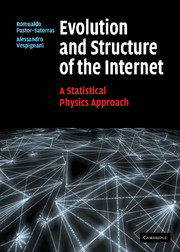Book contents
- Frontmatter
- Contents
- Preface
- List of abbreviations
- 1 A brief history of the Internet
- 2 How the Internet works
- 3 Measuring the global Internet
- 4 The Internet's large-scale topology
- 5 Modeling the Internet
- 6 Internet robustness
- 7 Virtual and social networks in the Internet
- 8 Searching and walking on the Internet
- 9 Epidemics in the Internet
- 10 Beyond the Internet's skeleton: traffic and global performance
- 11 Outlook
- Appendix 1 Graph theory applied to topology analysis
- Appendix 2 Interface resolution and router topology
- Appendix 3 Numerical analysis of heavy tailed distributions
- Appendix 4 Degree correlations
- Appendix 5 Scale-free networks: scaling relations
- Appendix 6 The SIR model of virus propagation
- References
- Index
7 - Virtual and social networks in the Internet
Published online by Cambridge University Press: 12 January 2010
- Frontmatter
- Contents
- Preface
- List of abbreviations
- 1 A brief history of the Internet
- 2 How the Internet works
- 3 Measuring the global Internet
- 4 The Internet's large-scale topology
- 5 Modeling the Internet
- 6 Internet robustness
- 7 Virtual and social networks in the Internet
- 8 Searching and walking on the Internet
- 9 Epidemics in the Internet
- 10 Beyond the Internet's skeleton: traffic and global performance
- 11 Outlook
- Appendix 1 Graph theory applied to topology analysis
- Appendix 2 Interface resolution and router topology
- Appendix 3 Numerical analysis of heavy tailed distributions
- Appendix 4 Degree correlations
- Appendix 5 Scale-free networks: scaling relations
- Appendix 6 The SIR model of virus propagation
- References
- Index
Summary
The Internet and the World Wide Web (also known as WWW or simply the Web) are often considered as synonyms by non-technical users. This confusion stems from the fact that the WWW is at the origin of the explosion in Internet use, providing a very user-friendly interface to access the almost infinite wealth of information available on the Internet. The WWW, though, is a rather different network in the sense that it is just made from a specific software protocol, which allows access to data scattered on the physical Internet. In other words, it is a virtual network which lives only as a sort of software map linking different data objects. Nevertheless, the Web finds a natural representation as a graph and it is a stunning example of an evolving network. New Web pages appear and disappear at an impressive rate, and the link dynamics is even faster. Indeed, the fact that we are dealing with virtual objects makes Web dynamics almost free from the physical constraints acting on the Internet. Any individual or institution can create at will new Web pages with any number of links to other documents, and each page can be pointed at by an unlimited number of other pages.
The Web is not the only virtual network present on the Internet. Users interactions and new media for information sharing can be mapped as well in a graph-like structure. The graph of e-mail acquaintances of Internet users is a well-defined example of social network hosted by the Internet.
- Type
- Chapter
- Information
- Evolution and Structure of the InternetA Statistical Physics Approach, pp. 140 - 165Publisher: Cambridge University PressPrint publication year: 2004



